All the Presidents' Pets (4 page)

6
Fast Times at White House High
Â
The following Thursday was the first day of the rest of my life. I woke up at 4:30 in the morning, staring at the ceiling and rehearsing my first question for my first White House briefing. I hadn't felt such nervous excitement since the morning of my first day in the third grade after I'd left Catholic school and been thrown into the public school system. Would I make friends? Would I make good grades? Would I get knifed? (As a nine-year-old, I'd made the mistake of watching
Blackboard Jungle
the night before.)
I was as prepared as I could be, having acquired and read every book in the Presidential Pet canon. Niall Kelly's
Presidential Pets
was the best, superior to Vera Foster Rollo's
Presidents and Their Pets.
As for Janet Caulkins's
Pets of the Presidents,
it was too derivative. Margaret Trumanâdaughter of Harryâlent an insider's perspective to
White House Pets,
which was precisely its downside. She furiously spun her father's exiling of Mike, their Irish setter, to a Virginia farm. (She blamed Secret Service agents for feeding him candy and giving him rickets.)
As for Doris Kearns Goodwin's
No Ordinary Ferret,
it read suspiciously in parts like several of the others.
My studies had consumed me and I'd barely stepped outside in the last week, furiously taking notes on my research.
There were some interesting patterns, as many of the pets bore an uncanny resemblance to their owners. William Howard Taft, our fattest Chief Executive, had a Holstein cow named Pauline. Peace-lover Woodrow Wilson had a gentle sheep named Old Ike. (Old Ike delighted visitors with his habit of chewing tobacco. Just like Wilson's League of Nations, though, Old Ike suffered a sad end. He developed an addiction to nicotine and died a junkie on a Maryland farm.)
Andrew Jackson, the first “Common Man” president, kept a cursing parrot named Pol. Pol even screamed obscenities during Jackson's funeral service, doubtless to the delight of “Old Hickory's” risen spirit.
The misshapen Zachary Taylor (giant head, short legs) had an equally odd-looking horse, the knock-kneed Old Whitey. The Yankee Coolidges shared two very patrician collies, Prudence Prim and Rob Roy. And Teddy Roosevelt, the indomitable former asthmatic, adopted a one-legged rooster with almost manic energy. TR's children made a crutch for the bird. (With thirty-six pets, Teddy Roosevelt held the record for the most.)
Only Millard Fillmore didn't have a pet.
Then there were the exotic or just plain weird pets. The flamboyant Martin Van Buren had tiger cubs, a gift from the Sultan of Oman. (Sadly for Van Buren, Las Vegas's Mirage Hotel would not open for another 110 years.) The Marquis de Lafayette brought President John Quincy Adams an alligator, which the sixth President kept in the East Room, far from his and wife Louisa's collection of silkworms. Coolidge, in second place with thirty-three pets, also housed at various times a pygmy hippo, a wallaby, an antelope, a large white goose named Enoch, and a raccoon named Rebecca. And George Washington had a jackass named Royal Gift, a gift from the King of Spain and the progenitor of Mount Vernon's line of acclaimed “supermules,” the best draft animals in Virginia.

Lincoln's dog Fido, the first presidential pet to be photographed. Animal lover Abe also had two goats named Nanny and Nanko, among other pets.

Benjamin Harrison's goat His Whiskers with Harrison's son Russell, three presidential grandchildren, and presidential dog Dash. The President himself had to chase down His Whiskers one day, after he raced off with the kids trailing in his cart.
Since World War II the pets were fewer and far less unusual. The best known was FDR's Scottie Fala, a gift from his cousin Margaret Suckley in 1940. Fala was not only beloved, he was a witness to history. He observed the Atlantic Charter summit aboard the USS
Augusta
alongside Churchill's poodle Rufus. Fala missed Yalta but he never missed a press conference. When Republicans charged that a naval destroyer had been sent, at great taxpayer expense, to retrieve Fala in the Aleutian Islands after being accidentally left behind in 1944, FDR shot back: “These Republicans have not been content with attacks on me, my wife, or my sons. No, not content with that, they now include my little dog, Fala.” It was a strategy apedâer, copiedâby Vice President Richard Nixon in his famous Checkers speech in 1952.

President Woodrow Wilson's sheep, including the tobacco-chewing ram Old Ike, kept the South Lawn shorn while the staff gardeners went off to battle during WWI.
Of course I loved any excuse to indulge my passion for all things presidential. And there were moments during my weeklong cram when I thought the subject of presidential pets might add up to something more than a collection of quirky factoids. But I quickly clipped my own wings. This assignment was simply an entryway to a more serious beat somewhere down the line, I hoped.
With First Pet trivia overcrowding my head, I walked down Connecticut Avenue, cut through Farragut Park, and turned onto 16th Street. The small but stately Hay-Adams Hotel stood on my right; St. John's, also known as “the church of the Presidents,” on my left. And in front of me, across Lafayette Square, was the White House.
Since 1800 it stood there, burned by the British in 1814, gutted for renovation by Harry Truman in 1948, targeted by Al Qaeda in 2001. But the outer walls had never given way. (Truman had insisted that the original exterior remain intact during the reconstruction, for the important symbolic value. For his efforts he treated himself to a South Portico balcony, henceforth named the Truman Balcony.) Irishman James Hoban's neoclassical design for the Executive Mansion won out over the othersâwhich, by the way, included Jefferson'sâbecause it was dignified, not extravagant like that of a European monarch's palace.
Abigail Adams, the first First Lady to live there, had to hang her laundry in the East Room. And on the mantel down the hall in the State Dining Room a quotation of her husband's was still inscribed: “I Pray Heaven Bestow the Best of Blessings on This House and All that shall hereafter inhabit it. May none but Honest and Wise Men ever rule under this Roof.”
I stopped for a moment, and, staring at the People's House, I felt a lump in my throat.
As I headed toward the northwest gate I thought of a deodorant ad from my childhood: Never let them see you sweat. I had to be confident, I told myself, as a few members of the press corps filed in ahead of me.
Easier said than done. The White House reporters wouldn't suffer fools gladly. They'd likely sneer at my beatâthese were people covering America's political nerve center. But I had to believe I could win their respect. I knew a few of them socially, so that was some comfort. The ones who didn't know me would soon discover that I had a genuine interest in the inner workings of the presidency; that covering Barney was simply my way in, my dues paying.
I flashed my freshly laminated credential. The sergeant buzzed me in. I pushed open the wrought-iron gate, then made my way through the metal detector. Suddenly I was on the grounds. On my right was a phalanx of video cameras on tripods, where television correspondents did their live stand-up shots from a patch of ground known as Pebble Beach. (The area used to be covered in gravel.) It was a short walk up the driveway and past the fountain on my left. If I'd kept going straight I'd have run right into the sentry guarding the Oval Office, at the end of the West Wing. The distance was surprisingly short so I cut sharply left and entered through the French doors.
I was standing in the Briefing Room. The first of the day's two briefings, known as the gaggle, would not begin for at least ten minutes so I quietly disappeared into the pressroom next door.
This room, which contained the reporters' “offices,” was underwhelmingâjust three short rows of cubicles, some more decorated than others, mostly unoccupied. The room was lined on three sides with booths for each of the broadcast networks and a few radio networks. I was struck first by the quiet, then by the smell, a combination of sweatsocks and stale French fries. The kitchen area stank. Downstairs, things were even dirtier.
I wasn't going to be given my own workspace, at least not anytime soon, so I timed my entrance so that I wouldn't have to stand awkwardly for too long. Upstairs I backed up against the beige-ish wall, hoping to blend in.
“Hey there, kiddo!” I turned to my left and down a bit to see a big smiling face.
“Andrea!” I hadn't seen NBC's pint-sized Andrea Mitchell in at least two years. “How are you?”
“How are
you
? I'm glad you survived Traficant.”
“Just barely. Let's just say I'm happy for the furlough.” She laughed, harder than she had to. She was a respected network reporter; I was from the bastard cable cousin. But she knew I needed the confidence boost. What I didn't need was the gratuitous brush of her hand against my backside. (I'd forgotten how everyone called her “Grabbyhands Mitchell” or “Handrea,” for short.) I'd always wondered if her husband, Fed chairman Alan Greenspan, had any idea how aggressive she could be. No matter, she was probably sweeter than anyone else in the press corps. In 1997 when I threw up at Jim Lehrer's Christmas party, she was the one who brought me upstairs and gave me a sponge bath.
“So you're covering the President,” she said.
“Yes, that's right.” I was, in a way.
“Good for you!” she cheered as she looked me up and down. “Nice to see you're working out,” she added with a squeeze of my biceps. Before this could go any further a voice announced over the PA that the press briefing was beginning in two minutes.
I followed the crowd back into the James Brady Briefing Room, a space I'd seen countless times on television. It used to be the pool where FDR would swim for exercise. President Nixon had the floor boarded over and carpeted for briefings. The room certainly had a temporary feel. Six rows of eight high-school-auditorium-style seats were bolted into the uneven floor, which was covered in a stained carpet of indeterminate color (somewhere between gray and brown). The chairs faced the familiar press secretary's lectern, which was backed by a cheap blue curtain at the head of the room. A sign stuck on the drape read “The White House.” The stucco ceiling hung low. Camera stands lined the sides and cluttered the back of the room. The walls were otherwise bare, except for one picture of Ronald and Nancy Reagan congratulating a wheelchair-bound former press secretary James Brady on the naming of the room. (At first glance I thought it was Larry Flynt.)
The room was so small, unimpressive, and uncomfortable. Nixon was smiling from his grave. This was his gift to the press corps.
As luck would have it, I did know some of the crowd that started trickling in, including Fox News's Jim Angle, who greeted me heartily.
“If you think it smells now, you should have been here yesterday. A dead muskrat was stuck behind one of the vending machines and, man, did it stink. I guess someone took care of it,” he said. “So what do you think?”
